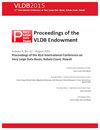演示GPT-DB:使用GPT-4为SQL处理生成特定于查询和可定制的代码
IF 3.3
3区 计算机科学
Q2 COMPUTER SCIENCE, INFORMATION SYSTEMS
引用次数: 1
摘要
GPT-DB用通用编程语言(如Python)生成用于SQL处理的代码。生成的代码可以使用用户提供的自然语言指令自由定制。例如,这使用户可以尝试使用特定的库进行SQL处理,或者在处理过程中生成非标准输出。GPT- db基于OpenAI的GPT模型系列,能够将自然语言指令翻译成代码的神经网络。默认情况下,GPT-DB利用最新发布的GPT-4模型,而访问者也可以选择以前的版本进行比较。GPT- db自动生成特定于查询的提示,指示GPT进行代码生成。这些提示包括目标数据库的描述,以及描述为自然语言文本的逻辑查询计划,以及用于定制的说明。GPT-DB使用参考数据库系统自动验证并可能重新生成代码以进行结果比较。它使用户能够选择用于训练的代码样本,从而提高未来查询的准确性。建议的演示展示了各种查询的代码生成,以及用于代码定制的不同指令。本文章由计算机程序翻译,如有差异,请以英文原文为准。
Demonstrating GPT-DB: Generating Query-Specific and Customizable Code for SQL Processing with GPT-4
GPT-DB generates code for SQL processing in general-purpose programming languages such as Python. Generated code can be freely customized using user-provided natural language instructions. This enables users, for instance, to try out specific libraries for SQL processing or to generate non-standard output while processing. GPT-DB is based on OpenAI's GPT model series, neural networks capable of translating natural language instructions into code. By default, GPT-DB exploits the most recently released GPT-4 model whereas visitors may also select prior versions for comparison. GPT-DB automatically generates query-specific prompts, instructing GPT on code generation. These prompts include a description of the target database, as well as logical query plans described as natural language text, and instructions for customization. GPT-DB automatically verifies, and possibly re-generates, code using a reference database system for result comparisons. It enables users to select code samples for training, thereby increasing accuracy for future queries. The proposed demonstration showcases code generation for various queries and with varying instructions for code customization.
求助全文
通过发布文献求助,成功后即可免费获取论文全文。
去求助
来源期刊

Proceedings of the Vldb Endowment
Computer Science-General Computer Science
CiteScore
7.70
自引率
0.00%
发文量
95
期刊介绍:
The Proceedings of the VLDB (PVLDB) welcomes original research papers on a broad range of research topics related to all aspects of data management, where systems issues play a significant role, such as data management system technology and information management infrastructures, including their very large scale of experimentation, novel architectures, and demanding applications as well as their underpinning theory. The scope of a submission for PVLDB is also described by the subject areas given below. Moreover, the scope of PVLDB is restricted to scientific areas that are covered by the combined expertise on the submission’s topic of the journal’s editorial board. Finally, the submission’s contributions should build on work already published in data management outlets, e.g., PVLDB, VLDBJ, ACM SIGMOD, IEEE ICDE, EDBT, ACM TODS, IEEE TKDE, and go beyond a syntactic citation.
 求助内容:
求助内容: 应助结果提醒方式:
应助结果提醒方式:


